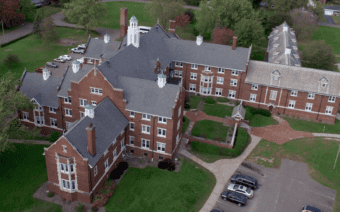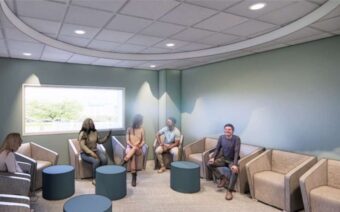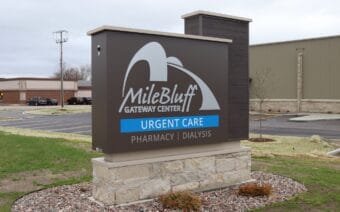
June 24, 2024
WHITEHALL – It had been more than 60 years since the residents in Whitehall and throughout the surrounding counties – Trempealeau, Jackson and Buffalo – have seen a new hospital.
That changed when Gundersen Health System built a new, state-of-the-art hospital at 18601 Lincoln St. in Whitehall.
The new hospital, Joni Olson, administrator at Gundersen Tri-County Hospital, said sits on the same site as the previous building.
“We owned enough property and footprint (on the site) to build the replacement hospital on the same property next to where the old hospital was – the previous hospital on site was razed and torn down last fall,” she said.
The $51 million project broke ground in March 2022 and started welcoming patients last July.
“The project was funded by our operations by a loan/bond, and the only grant we received was for solar – that was an HRSA (Health Resources & Services Administration) grant,” Olson said.
The multi-year project was celebrated with a ribbon-cutting ceremony in mid-May.
“A ribbon cutting and dedication symbolizes a new beginning,” Olson said. “With Bellin Health and Gundersen Health System coming together to become Emplify Health, we continue our mission to inspire your best life by caring, learning and innovating.”
Whitehall Mayor Jeff Hauser, Independence Mayor Robert Baecker and Trempealeau County Board Supervisors Kevin Adams and Jeanne Nutter were in attendance, as were representatives from Sen. Tammy Baldwin and Rep. Derrick Van Orden’s offices.
Olson said it serves about 20,000 in the Trempealeau County area.

“The closest hospital (if we didn’t have the new facility in Whitehall) would be either La Crosse or Eau Claire – we are centrally located between the two cities,” she said. “Those are about 45-50 miles away, respectively. Black River Falls Memorial is approximately 35 miles away – that’s another critical-access hospital. Winona, Minnesota, has another hospital in the surrounding area. This is rural Wisconsin – there are no interstates or direct shots to get to other hospitals. When you live 50 miles from the closest center, that emergency room and critical care is of the utmost importance – it’s life-saving many times.”
What the new hospital offers
Olson said the planning of the new hospital goes back five or six years.
“The people and communities we serve have responded nicely,” she said. “They have supported us and are using us for their medical needs. Our volumes have grown in every department and area of this hospital.”
Though growth was one reason for the new hospital, Olson said there is more to the story.
“With the old hospital (and going back further), we’ve had a hospital in this area of western Wisconsin for 107 years,” she said. “The old hospital – built in 1962 – had outlived its useful life. It had so many needs that it was determined it would be better served to build a new hospital.”
Olson said the new hospital is double the size of the previous building.
“We have 24 private, in-patient rooms,” she said. “We have two functional, fully equipped operation rooms, with several pre- and post-operation rooms. We have infusion services and a robust therapy department that’s equipped for physical therapy, cardiac therapy and occupational speech.”
Olson said the new hospital also has an attached, renovated primary care clinic.
“We have a (helicopter landing pad) on-site for immediate transport,” she said. “We also have numerous areas open to the community, including a café and a gift shop – it’s extremely accommodating.”

The new hospital, Olsen said, also has telemedicine capabilities.
“We offer remote consults – the new hospital is well equipped,” she said. “The old facility was built in the 1960s before this technology was available. We had to come into the 21st century.”
Sustainability efforts
Olson said a new solar array will eventually provide about 50% of the hospital’s energy use in the new hospital.
“The completion of the solar panels will be done mid-July,” she said. “The building is energy efficient, but I can’t say we’re 100% green. We took the energy and environment into consideration when the new hospital was built.”
The use of solar energy, Olson said, isn’t a new concept for Gundersen Health System, as the renewable energy type has been incorporated into other recent building projects.
Doing so not only reduces Gundersen’s carbon footprint, but it lowers costs, which can be passed on.
The panels, Olson said, were funded in part by the $1 million federal grant.
 Aspirus Wausau Hospital completes Emergency Department expansion
Aspirus Wausau Hospital completes Emergency Department expansion New office, cohort for Appleton’s start-up ecosystem
New office, cohort for Appleton’s start-up ecosystem








